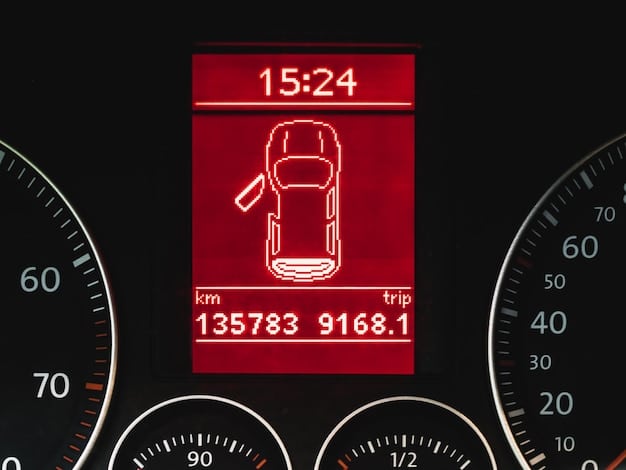2025 Car Buying: How Safety Tech Affects Your Insurance Costs

2025 car buying will be heavily influenced by the integration of advanced safety technologies, which significantly impact insurance costs by reducing accident rates and potentially lowering premiums for vehicles equipped with these features.
Navigating the 2025 car buying landscape involves considering the impact of new safety technologies on insurance costs; understanding how these features affect premiums can save you money. Will your next car’s tech lower your insurance?
Understanding the 2025 Car Market and Safety Tech
The 2025 car market is poised to be a showcase of cutting-edge safety technologies. These advancements aim to reduce accidents, improve driver awareness, and ultimately save lives. But how exactly do these technologies translate into savings on your insurance premiums?

Several key factors are driving the integration of these safety systems. These include stricter safety regulations, consumer demand for safer vehicles, and the decreasing cost of technology. Let’s delve into the specifics.
Key Safety Technologies in 2025 Cars
The safety features in 2025 cars are a significant leap from previous years. Here are some of the most important ones:
- Automatic Emergency Braking (AEB): Detects potential collisions and automatically applies the brakes to prevent or mitigate the impact.
- Lane Departure Warning (LDW) and Lane Keeping Assist (LKA): Alerts drivers when they drift out of their lane and assists in steering the vehicle back into the correct lane.
- Adaptive Cruise Control (ACC): Maintains a safe following distance from the vehicle ahead and adjusts speed accordingly.
- Blind Spot Monitoring (BSM): Alerts drivers to vehicles in their blind spots, reducing the risk of lane-change accidents.
These technologies are not just about making driving easier; they are about making it safer and more reliable. As these features become standard, their impact on insurance costs will become increasingly apparent.
Advanced driver-assistance systems (ADAS) are evolving rapidly, making vehicles safer and potentially more affordable to insure in the long run. With increased adoption and proven effectiveness, these technologies are reshaping the future of driving.
How New Safety Features Reduce Accident Risk
One of the primary reasons insurance companies are interested in safety tech is its potential to reduce accident risk. By mitigating human error, these technologies are expected to significantly lower the frequency and severity of collisions.
Studies have shown that vehicles equipped with advanced safety systems experience fewer accidents compared to those without. Here’s a closer look at how specific features contribute to this reduction:
The Impact of AEB and LDW
Automatic Emergency Braking (AEB) and Lane Departure Warning (LDW) systems are particularly effective in preventing accidents. AEB can significantly reduce rear-end collisions, while LDW can prevent sideswipe accidents.
- AEB Effectiveness: Studies indicate that AEB can reduce rear-end collisions by up to 40%.
- LDW Effectiveness: Lane Departure Warning systems have been shown to decrease the rate of single-vehicle crashes by as much as 20%.
- Combined Benefits: When combined, these systems offer a comprehensive safety net, providing drivers with an added layer of protection.
Lower accident rates directly translate into fewer insurance claims, which in turn can lead to lower premiums for drivers. Understanding these benefits is crucial when considering a new car purchase.
The reduction in accident risk is a key factor influencing insurance companies’ decisions to offer discounts for vehicles equipped with these safety features. Investing in a safer car is not just a personal safety choice; it’s also a smart financial decision.
Insurance Premiums: Discounts for Safety Tech
Insurance companies are increasingly recognizing the value of advanced safety technologies. Many insurers now offer discounts for vehicles equipped with these features, reflecting the reduced risk of accidents.

The amount of the discount can vary depending on the insurance company and the specific safety features included in the vehicle. However, these savings can add up over time. Here’s what to consider:
Factors Influencing Insurance Discounts
Several factors influence the availability and amount of insurance discounts for safety tech. Understanding these can help you maximize your savings.
- Specific Safety Features: The more advanced safety features a vehicle has, the higher the potential discount.
- Insurance Company Policies: Different insurance companies have different policies regarding discounts for safety tech.
- Driving History: Your driving history also plays a role. A clean record combined with safety tech can result in significant savings.
Shopping around and comparing quotes from different insurance companies is essential. Be sure to inquire about any available discounts for vehicles with advanced safety features to find the best deal.
Insurance premiums can be significantly reduced by opting for vehicles with advanced safety systems, reflecting the lower risk profile these technologies offer. This makes the initial investment in safety tech even more worthwhile.
The Cost of Repairing Advanced Safety Systems
While advanced safety technologies can lower insurance premiums by reducing accident risk, they can also increase repair costs. These complex systems often require specialized tools and expertise to repair, which can drive up labor and parts expenses.
When accidents do occur in vehicles with advanced safety systems, the repair process can be more complicated. Here’s what to consider:
Potential for Higher Repair Bills
The advanced technology in these systems means that even minor accidents can result in significant repair bills. Sensors, cameras, and other components may need to be recalibrated or replaced, adding to the overall cost.
However, while the initial repair costs might be higher, the long-term benefits of reduced accident frequency and severity often outweigh these expenses. In the end, the goal is to avoid accidents altogether.
Advanced safety features can increase repair costs, but the overall reduction in accidents and injuries can lead to long-term savings and improved safety.
Long-Term Trends: How Safety Tech Will Shape Insurance
Looking ahead, the integration of advanced safety technology is expected to have a profound impact on the insurance industry. As these features become more prevalent and effective, insurance companies will continue to refine their pricing models.
Several long-term trends are expected to shape the future of car insurance. These include:
The Future of Car Insurance
Several trends will influence the way insurance companies assess risk and set premiums in the coming years. These include the increasing prevalence of autonomous driving features and the availability of real-time data.
- Autonomous Driving: As autonomous driving features become more advanced, insurance companies may shift from focusing on driver behavior to focusing on the vehicle’s technology.
- Real-Time Data: Insurance companies may use real-time data from vehicles to assess driving risk and adjust premiums accordingly.
- Subscription-Based Insurance: Subscription-based insurance models may become more common, offering personalized coverage based on individual driving habits and needs.
These trends will likely lead to more personalized and data-driven insurance pricing, benefiting drivers who prioritize safety and responsible driving.
Technological advancements, particularly in autonomous driving and data analytics, will reshape the insurance landscape, offering more personalized and cost-effective solutions for drivers.
Making Informed Car Buying Decisions in 2025
When buying a car in 2025, it’s crucial to consider the long-term costs and benefits of advanced safety technologies. By weighing the initial investment against potential insurance savings and increased safety, you can make a well-informed decision.
Before making a purchase, take the time to research different models and their safety features. Consider the following:
Tips for Car Buyers
Here are some tips to help you make the right choice when buying a car with advanced safety features:
- Research Safety Ratings: Check safety ratings from organizations like the Insurance Institute for Highway Safety (IIHS) and the National Highway Traffic Safety Administration (NHTSA).
- Compare Insurance Quotes: Get quotes from multiple insurance companies to see how the cost of insuring different models varies based on their safety features.
- Consider Long-Term Costs: Don’t just focus on the purchase price. Consider the long-term costs of ownership, including insurance, maintenance, and repairs.
By doing your homework and considering all the factors involved, you can find a car that meets your needs and budget while providing the highest level of safety.
In summary, informed car buying in 2025 involves weighing the initial cost against potential insurance savings, long-term maintenance, and the enhanced safety provided by advanced technologies.
| Key Aspect | Brief Description |
|---|---|
| 🚘 Safety Tech | Advanced systems reduce accidents and injuries. |
| 💰 Insurance Discounts | Insurers offer lower premiums for safer vehicles. |
| 🛠️ Repair Costs | Complex systems may increase repair expenses. |
| 📈 Long-Term Trends | Autonomous driving and data analytics will shape future insurance. |
Frequently Asked Questions (FAQ)
▼
While many insurance companies offer discounts for advanced safety features, this isn’t universally guaranteed. Your driving record and the specific policies of the insurer also play significant roles.
▼
Yes, Automatic Emergency Braking (AEB), Lane Departure Warning (LDW), and Adaptive Cruise Control (ACC) often provide the most significant insurance discounts due to their proven impact on accident reduction.
▼
Higher repair costs can offset some insurance savings, but the primary benefit of safety tech is preventing accidents altogether, which leads to fewer claims and sustained long-term savings.
▼
Potentially, yes. As autonomous driving features improve and accident rates decrease, insurance companies may shift to focusing on the technology’s performance rather than the driver’s behavior, leading to lower premiums.
▼
Research safety ratings from IIHS and NHTSA, compare insurance quotes for different models with varying safety features, and factor in the total cost of ownership, including potential repair expenses.
Conclusion
The integration of advanced safety technologies in 2025 car buying decisions presents a compelling opportunity to enhance safety and potentially reduce insurance costs, making it essential to weigh the initial investment, long-term maintenance, and available discounts when making your next vehicle purchase.





